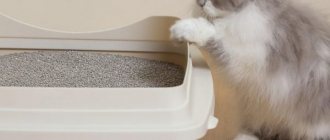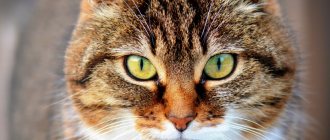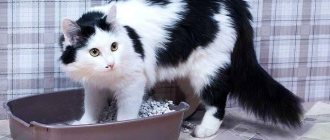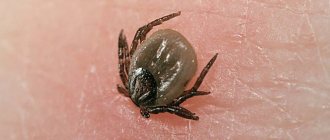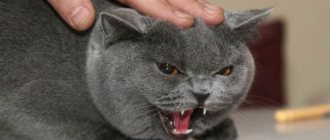Cats develop unusual habits due to their quirky personalities. They may run around the house, hide in confined spaces, rub their heads against the wall, and much more.
These habits are quite natural for many cats. If your kitten spends a long time in the litter box, you may consider the behavior harmless and accept the kitten as it is.
However, if your cat develops this behavior later in life, you should pay attention to her health. Any unusual behavior may indicate an illness, and you should take your cat to the vet as soon as possible. This article will look at all the possible reasons why a cat sits in a litter box for a long time.
Pathological causes of frequent urination
Frequent urination is often not associated with various diseases of the genitourinary system.
However, it is important for any owner to know how such pathologies manifest themselves in order to provide first aid to the animal and take it to the veterinarian in time
Cystitis
This disease is one of the most common genitourinary diseases in domestic cats. The initial stage of the pathology has no external manifestations, but over time, inflammation of the bladder mucosa causes urination problems.
Any pet owner can recognize the signs of the disease:
- the cat often sits down to pee, but there is no urine, or it comes out in small portions;
- the animal begins to meow before urination begins, and continues to do so during the process;
- the pet often licks the perineum;
- the cat has a tense stomach and sometimes starts vomiting;
- the animal is thirsty all the time;
- urine has changed color to darker;
- the appearance of an ammonia odor from animal secretions.
Cystitis cannot be neglected, as it can become chronic. The most common causes of pathology are the animal’s lack of protein food, a small amount of fluid, infection, hypothermia, kidney inflammation, and helminthic infestation.
Urolithiasis disease
This disease most often develops in older or neutered animals. Rarely, the disease is diagnosed in young pets.
If your cat often runs to pee and his appetite has decreased, measure the animal's body temperature. Elevated levels combined with lethargy, vomiting and dark-colored urine almost certainly indicate the development of urolithiasis. Pathology is caused by:
- unhealthy diet with a predominance of foods that contain purines, calcium, phosphorus, potassium;
- flavored and canned additives from inexpensive industrial feeds;
- infectious lesions;
- excess weight;
- lack of water for drinking;
- predisposition to the disease at the genetic level.
Diabetes
This disease is called "fat man's disease." Diabetes most often affects overweight pets. Their body does not cope well with the absorption of glucose, so animals instinctively try to lower its concentration with large quantities of water.
Table 2. Signs and causes of diabetes in cats
| Symptoms of the disease | What causes the disease |
| The cat often goes to the toilet in small quantities, but the amount of urine does not decrease | Stressful state |
| The animal is very thirsty, regardless of the weather | Disturbance of hormonal processes |
| The pet does not feel pain during urination (if the disease is not advanced) | Pregnancy |
| In the case of a long-term illness, the cat’s weight drops sharply, interest in games disappears, vomiting may begin, and appetite changes are observed. | Using inappropriate foods in the diet |
When diabetes develops, a cat's breath begins to smell like acetone. If such a symptom appears, it is necessary to urgently show the animal to a doctor.
Cushing's syndrome
This pathology is hormonal and is rarely diagnosed in domestic animals.
To prevent possible illness, it is important to carry out preventive examinations on a regular basis.
The disease can be triggered by treating your pet with corticosteroids or a tumor in the adrenal gland or pituitary gland. Hormonal imbalances lead to impaired cortisol production, which gives rise to the development of Cushing's syndrome.
Signs of the disease:
- loss of appetite, rapid weight gain;
- thirst;
- frequent urination;
- development of apathy;
- the appearance of defects on the pet’s skin and fur.
Sometimes Cushing's syndrome develops as a result of diabetes. To establish a diagnosis, special tests are performed, urine and blood tests are performed, and the animal is given x-rays and ultrasounds.
Treatment for urinary problems
If you notice that your pet goes to the litter box very often - several times a day - but cannot urinate fully. What to do in this case? The animal must be shown to a veterinarian immediately.
In a hospital setting, doctors will be able to remove urine that has stagnated in the bladder, as well as prevent the development of dehydration.
The animal will receive painkillers and antibacterial agents. After the symptoms are relieved, it is handed over to the owner.
If your pet is predisposed to the formation of kidney stones, then he needs to follow a special diet.
- Any foods containing salt must be excluded from the menu.
- Fresh meat and fish products are completely prohibited.
- Milk should be excluded from the diet as it contains a high percentage of magnesium.
- It is strictly forbidden to feed pork. It is too fatty and can increase the density of urine, impairing its removal from the bladder.
To avoid “dry litter box” problems, it is necessary not only to monitor your furry pet’s diet, but also to regularly show your cat to the veterinarian for preventive purposes.
Why do cats sleep in the litter box?
Today we will continue our discussion of the strange habits that cats have and discuss why some cats tend to sleep in their litter box. There are probably many cat owners who have noticed that the cat, having gone to the toilet (or other place where the tray is located), instead of taking care of its natural needs, simply sits in it.
Usually the owner watches and waits for the cat to “get down to business”, but instead of meeting his expectations, she just sits down more comfortably and, turning her tail, continues to sit, only occasionally turning to her owner with such an expression, the word asks him “well , why are you staring, can’t I sit?” The situation is quite common, and, as a rule, does not bother the owner too much. In most cases, this behavior is characteristic of cats only at that stage of their stay in the house, when they were just brought there and in the next few days. Over time, this passes, and the owner forgets about this strange whim of his pet.
How to calm a cat during heat: 3 ways
A cat's heat lasts about two weeks, in some cases longer. The animal experiences stress 3 times a year if castration has not been performed. There are often cases in which an imbalance of hormones occurs in a cat’s body, as a result of which estrus may occur more often. Regarding cats of oriental breeds, they are more susceptible to displaying love than pets bred in other countries. A characteristic feature of estrus is considered to be the unstable condition of the pet. The owner, in turn, grabs his head, wanting to help his pet.
Why can’t my cat go to the toilet in a small way and what should I do?
Often cats suddenly develop health problems, and the owner does not know what to do or how to help the pet. If the cat cannot go to the toilet in a small way, then, of course, you need to quickly contact a veterinarian. In our article we will try to explain in more detail the problems of this disease, what the causes of this condition may be, and how to provide all possible help to your pet.
From normal to alarming symptoms
Until puberty (6-7 months), a kitten usually urinates 2-4 times a day.
Adult animals – 1-3 times. Sometimes healthy cats can walk up to 5 times a day, or vice versa very rarely, once every 2 days (how normal this is will be determined by general health and tests).
In most cases, you can already start to worry if the cat has not peed all day.
Symptoms of difficult and painful urination are easy to notice. The animal wants to, but cannot, empty itself and sits in the toilet for a long time. Shows anxiety, constantly licks the urethral area and meows anxiously.
During inflammatory processes, urine is still released in small portions. You may see drops of blood or pus in the tray. With a mechanical blockage, the animal cannot pee at all. The abdominal wall becomes tense and painful.
Urinary retention leads to life-threatening conditions. Most often, owners worry that the bladder will not withstand the strain and will rupture, but no less terrible is intoxication of the body. In addition to this, stagnant urine is an ideal environment for pathogenic bacteria.
(adsbygoogle = window.adsbygoogle || ).push({});
If the cat does not pee, has stopped eating and drinking, or has become lethargic, you need to urgently find out the reason, provide first aid and not delay going to the clinic.
Safe deviations from the norm
Stress can disrupt a cat's routine.
The animal may occasionally experience deviations from the norm when urinating. The pet can walk small once every 1-2 days. The reason may be:
- stress;
- climate change;
- change of feed;
- carrying out sterilization or castration.
As for sterilization and castration, it takes up to 2-3 days for cats to restore function. Neutered cats take longer days because they undergo deep surgery. The first days after the procedure, they go to the toilet through a catheter.
Pathological deviations from the norm
The genitourinary system of a cat.
If your cat has not gone to the toilet for more than 2 days, or urination is difficult, comes in scanty doses, then you should examine the animal.
Inflammatory processes in the body can be accompanied by the following symptoms:
- lack of urination;
- difficulty urinating with scanty discharge;
- it is painful for the animal to go to the toilet, which is expressed by frequent meowing;
- the presence of various impurities in the urine (blood, mucus, sand);
- apathy, bad mood;
- lack of appetite;
- elevated temperature;
- general poor health (dry and hot nose, hot tips of the ears, pale and unhealthy-looking gums);
- swelling in the abdominal area.
Urolithiasis
Frequent diseases in adult cats and kittens may include urolithiasis and kidney disease.
Symptoms of urolithiasis.
They often occur due to hypothermia, as well as poor nutrition, cheap feed, and poor animal hygiene. They affect cats more, both regular and neutered, due to the specific structure of the genitourinary system.
If the animal has no desire to go to the toilet for more than two days, the pet does not feel well, its stomach is swollen, or there are any impurities in the urine, then immediately contact your veterinarian. If the disease progresses, surgery may be required.
Don't forget to change the water in your cat's bowl.
To protect your pet from urinary problems, owners should:
- feed your cat or cat in a balanced manner (2-3 times a day);
- give clean water;
- include in the diet not only dry food, but also canned food, boiled chicken, meat, fish (no more than once a week), dairy products, cereals;
- wash the tray thoroughly;
- keep the house clean;
- do not allow the animal to become hypothermic;
- notice changes in your pet’s behavior in time and contact a veterinarian.
The health of cats depends primarily on their diet. As a rule, kidney and bladder diseases often occur in overweight cats.
In addition, food also influences the occurrence of pathologies. It is not recommended to give dry food frequently. Veterinarians advise choosing premium products. If your pet already suffers from urolithiasis, then it is necessary to include appropriate food in its diet.
How many times a day should a cat go to the toilet?
Problems with going to the toilet are one of the most common and familiar to all cat owners. Some people think that their pet goes to the toilet too often, while others think that it goes to the toilet too rarely. And this is really a serious cause for concern, because in both cases such behavior can be a consequence of illness. So, how many times should a cat go to the toilet, and when should you start to worry?
Why can’t my cat go to the toilet in a small way and what should I do?
Often cats suddenly develop health problems, and the owner does not know what to do or how to help the pet. If the cat cannot go to the toilet in a small way, then, of course, you need to quickly contact a veterinarian. In our article we will try to explain in more detail the problems of this disease, what the causes of this condition may be, and how to provide all possible help to your pet.
First aid
Now let's move directly to the question of what to do, how to get a kitten, cat or female cat to go to the toilet?
It is not possible to induce urination in case of trauma or congenital defects on your own.
For cystitis, urethritis or urolithiasis, first aid is to relieve urethral spasm. No-spa and its domestic analogue Drotaverine belong to the category of drugs that are contraindicated for cats.
An intramuscular injection of Papaverine at the same dosage (0.1 ml/kg) has a similar effect without potential harm.
In addition to spasmolytic, spasmalgon also has a mild analgesic effect (dosage 0.1 ml/kg, IM). Heat applied to the pelvic area will help alleviate the condition a little if the body temperature is within the normal range (37.5-8.5°C).
In some cases, a gentle massage can help your cat empty his bladder. It is done in case of non-critical filling of the bladder and only if it does not cause pain to the animal.
In case of high fullness and complete obstruction, massages are contraindicated. It still won’t be possible to “squeeze out” the stone or relax the urethra, but it’s easy to injure the walls of the organs.
It doesn’t matter whether a cat is neutered or not, if he suffers from urolithiasis, attacks of retention will occur periodically. During the period of exacerbation and movement of stones, as well as courses for prevention, Kot Erwin or Cystenal (a preparation from the roots of madder) are indicated.
They are used to relieve spasms, facilitate the release of sand and small stones of phosphate and oxalate nature. After taking cystenal, the urine turns into a characteristic reddish tint. Courses of treatment 1-2 months
During the period of exacerbation and movement of stones, as well as courses for prevention, Kot Erwin or Cystenal (a preparation from the roots of madder) are indicated. They are used to relieve spasms, facilitate the release of sand and small stones of phosphate and oxalate nature. After taking cystenal, the urine turns into a characteristic reddish tint. Courses of treatment are 1-2 months.
Attention! If the urinary tract is blocked and the bladder is full, it is very dangerous to give a diuretic. It will not solve the problem, but will add water to an already distended urinary tract.
How to tell if your pet has urinary problems
If a cat cannot go to the toilet in a small way, then it will be difficult not to notice, because she moans loudly, meows, and screams in a voice that is not her own. When she does manage to urinate, very little urine comes out. The pet can come up to its tray, stomp next to it, and snuggle up to it. It’s as if he doesn’t dare to go into it; in fact, the cat is trying to help himself go to the toilet to urinate. He does not allow you to touch his bloated belly, like a drum, which is very painful. The pet cannot lie on its tummy. Sometimes there are traces of pus or blood in the tray.
Time alone
Cats may spend most of their time in the litter box to be alone. The litter box is their paradise, where no one bothers them.
If they are tired from the daily chores, they may decide to spend the rest of their time alone in the litter box.
If the litter box is located in a suitable corner of the house, cats can spend most of their time in the litter box. If so, we can confirm that your cat certainly enjoys your litter box cleaning skills.
How to train a cat to go to place
The cat began to shit wherever she wanted, just not in the litter box. What can you do if you notice that your pet has started going to the toilet in a different place?
If everything is fine at home, then perhaps the reason is in the toilet itself:
- the tray should be slightly larger than the animal itself;
- change the contents in the tray;
- do not use fragrances, she may not like the smell;
- Clean your cat's litter box as often as possible;
- purchase trays with high borates for adult cats, and low ones can be used for kittens;
- If a cat goes to the toilet past the tray, then there is no point in scolding him.
Safe Haven
Cats may behave differently when they are under duress or stress. There can be many reasons that can cause anxiety problems in cats.
Changing a cat's fixed schedule can be one of the most common reasons why a cat behaves this way.
The litter box may be the only place in the house where they feel most safe, and they probably struggle to find a calming environment.
Kittens are more prone to this behavior. If they are sitting in litter boxes, the kitten is likely continuing his habit. They may find a small, cozy litter box more comfortable than a cat bed.
© shutterstock
How many times a day do dogs urinate in normal condition?
The daily amount of bladder emptying that is considered normal for a dog is influenced by quite a few factors, including:
- Age of the animal. In a puppy, the urge to urinate occurs much more often, but as the puppy grows older and the muscular system develops, the body adjusts to longer breaks between “trips to the toilet.” At the same time, in older dogs, due to natural degenerative processes, the condition of urinary incontinence may begin to gradually return.
- Sex and fertility (the ability to create offspring). As a general rule, unsterilized males urinate more often than females, but this is not due to the peculiarities of the genitourinary system, but to the fact that the animal uses urine to mark its territory and leaves warning signals for “competitors” and inviting signals for potential partners);
- Estrous (relatively speaking, menstrual) cycle in females. During estrus, the blood supply to the female's pelvic organs increases, which can increase the urge to urinate, but the main reason for more frequent emptying of the bladder is the same marks that the estrous bitch, like the male, tries to leave literally everywhere.
- Time of year and weather conditions. The cooler the weather, the more often the dog pees, since in the heat a large amount of liquid is spent on cooling the body - through the work of sweat and salivary glands (sticking out the tongue for a dog is a standard way to reduce body temperature).
- Type of food. If there is a lot of liquid in the food, the animal will urinate more often. Dogs that eat exclusively dry food drink a lot, but rarely pee.
- The amount of water you drink over the next few hours.
- Steady state. An adult dog can be taught to empty its bowels and bladder once a day, for example, if the owner cannot walk the pet more often.
- Breed and size of the animal. Small toy dogs usually urinate somewhat more often than larger ones.
- Emotional condition. A dog can react to any strong emotion, both positive and negative, by changing the frequency of urination, although more often in the direction of increasing it.
- Current health status. In inflammatory processes accompanied by hyperthermia (increased body temperature), as well as gastrointestinal disorders (profuse diarrhea or vomiting), the amount of fluid in the body decreases significantly, dehydration develops, and accordingly, urination becomes more rare.
- Individual characteristics of the individual. First of all, we are talking about the quality and speed of metabolic processes in the body, as well as the state of the genitourinary system, the presence of chronic diseases, etc.
There are no strict criteria for determining the normal amount of urination in a dog during the day. For puppies, emptying the bladder 10–15 times a day is not a pathology; in adult animals, this can occur during regular daily walks of 7–10 “approaches.”
The right steps for owners or what to do if the cat can’t pee?
When keeping pets, you often have to deal with the pathology of such a process as urination. Noticing that the cat cannot pee, what should the owner do in such a situation? There can be several reasons for disruption of natural intercourse: from banal sexual overstimulation of a male to serious kidney diseases. The first thing to do in this situation is to immediately provide the animal with qualified assistance.
How to identify the problem
It is more difficult to notice similar signs in cats visiting the street or living in a private home. If your pet exhibits symptoms of urinary problems, you should immediately take him to a veterinarian. There may be several reasons for the development of such a pathological condition of the urinary system.
Diagnosis of the causes of pathology of urination is complex. A urine test is informative, suggesting an inflammatory process, urolithiasis. A diagnostic examination of the kidneys and bladder using ultrasound can reveal the presence of salt formations in the organs and establish urolithiasis in a pet.
First aid for an animal
If a cat can't pee, what can you do to help the animal? Often, when owners discover a problem in their pet, they turn to pet stores or veterinary pharmacies, where I advise them to purchase the drugs “Stop-cystitis” and “Kotervin”. In the early stages of development of urinary pathology, these drugs will relieve pain and inflammation, but such self-medication can be fatal for the animal.
If you notice signs of difficulty urinating, scanty amounts of urine, or blood in the tray, you should immediately seek veterinary advice. The owner should be aware that urinary retention for more than a day is a life-threatening condition for the pet and can lead to death.
Catheterization
In a clinical setting, a veterinarian may perform manual bladder massage. Sometimes this is enough to remove the sand plug. If the massage does not produce results, the doctor performs catheterization. This procedure is the only way to remove urine from the bladder and save the animal’s life. The manipulation can be carried out by a veterinary specialist at home, but it is better to do it in a specialized institution. Before the procedure, the animal is given anesthesia, and in case of contraindications, sedatives are given.
Conservative treatment
Regardless of the reasons that gave rise to difficulty urinating, the animal is given painkillers to relieve pain; in severe cases, novocaine blockade is used. The use of no-shpa and other antispasmodic drugs in the form of injections has a good effect. After the pain is relieved and the spasm is relieved, treatment will be aimed at the immediate cause of the pathology. For urolithiasis, anti-inflammatory drugs, antibiotics, agents that absorb salt formations, vitamins, antispasmodics and analgesics are prescribed
Particular attention should be paid to diet
In the case of cystitis and urethritis, treatment will be similar, with the exception of drugs that dissolve stones.
Surgery
Unfortunately, conservative treatment of cystitis, urolithiasis and other pathologies of the urinary system is not always effective. In this case, veterinary specialists recommend surgery. If stones are detected in the bladder, a cavitary cystotomy is indicated, and if they are localized in the urethra, a preanal urethrostomy is performed.
If the cause of urination pathology is sterilization, then the question of what to do to make the cat pee after surgery is by no means idle. In case of postoperative complications, it is better to show the animal to a veterinarian. He will prescribe appropriate treatment and empty the bladder using massage or catheterization.
If the owner notices that the pet has problems with urination, you should not self-medicate. The animal should be immediately shown to a veterinarian, since a full bladder is a threatening condition for the health and life of a pet.
Treatment
If a cat does not walk for several days or does so rarely, then a large number of microorganisms multiply in his bladder. At first, the cat should be in a hospital so that stagnant urine can be professionally removed. Using injections, fluid is administered to the pet to eliminate dehydration. The veterinarian also prescribes antispasmodic drugs to help relieve pain and relax the urethra. Antibiotics and antibacterial agents are usually used to help relieve inflammation in the bladder. After treatment, the cat is discharged home, where all care falls on the owner.
Corrective diet
If a cat is susceptible to urolithiasis, then it needs a corrective diet. It is necessary that the food be rich in vitamins B6, A and glutamic acid. Food should not contain salt and minerals, namely:
- The cat should have a complete exclusion of salty foods.
- Raw fish and meat are prohibited.
- The consumption of all types of fish is excluded. Phosphorus, found in any type of fish, is deposited as an excess mineral in the bladder and leads to the formation of stones.
- Milk should not be consumed by a pet with urinary problems. The point is the increased magnesium content, which will lead to even worse urine flow.
- Pork is too fatty meat, it will lead to thickening of urine, which will further complicate its outflow from the bladder.
The cat should eat special dry food, balanced for animals with problems in the genitourinary system.
Risk categories
Problems with urination often occur in cats that have undergone castration as children. There are cases when urinary retention occurs in kittens, but according to statistics, adults most often suffer from this condition, especially in cats. If a newborn kitten has a problem with urine discharge, then the reason, as a rule, lies in congenital mechanical obstruction of the urinary tract.
Preventive measures
It is quite difficult to cure the reason why a cat cannot urinate; out of 10 cases there will be 9 obligatory relapses. To alleviate your pet’s condition, preventive measures are important:
- Avoid overcooling your cat. The pet should not lie in a damp place, on concrete; if he wants to soak up the sun, it is better to do this on a warm blanket.
- Timely vaccination will lead to fewer diseases, which means fewer microorganisms will enter the cat’s body.
- A well-designed diet for an animal helps to avoid recurrences of inflammatory conditions in the animal’s genitourinary function. It is necessary to completely exclude all prohibited foods. Even once using a prohibited product can cause a relapse.
- Drinking plenty of fluids helps flush out your pet's bladder. Moreover, the water must be fresh and clean, and always be freely available to the animal.
- There is a special dry food available for sale for cats with disorders of the genitourinary system.
Unfortunately, it is impossible to completely cure urolithiasis in a cat. A caring owner should surround the pet with attention, regular preventive examinations, constant use of medications and a balanced diet. Such measures will help the cat lead a normal life.
